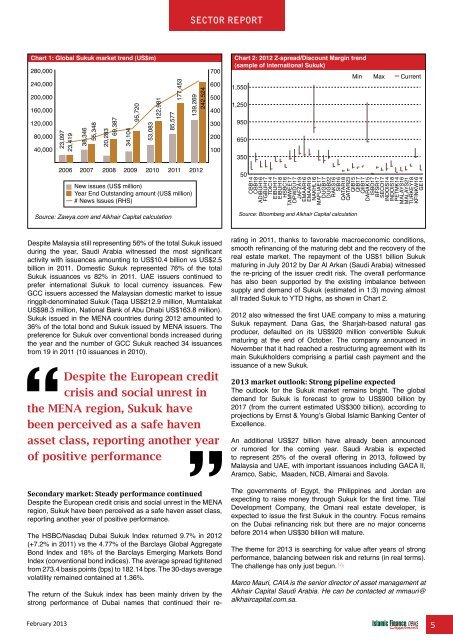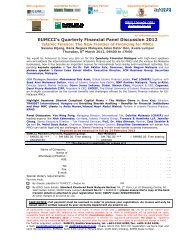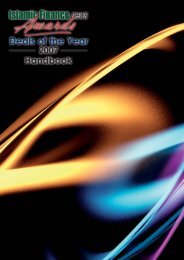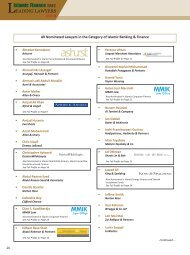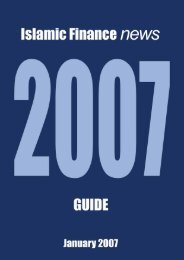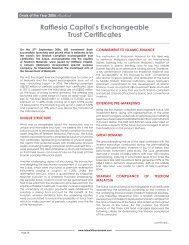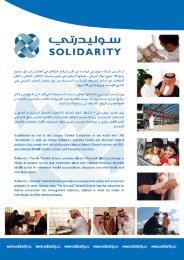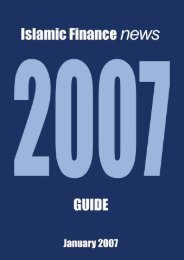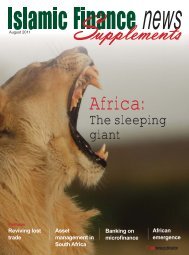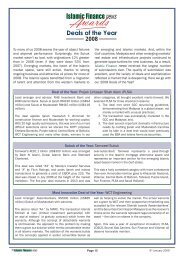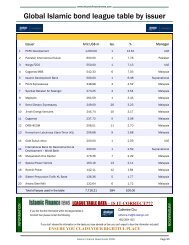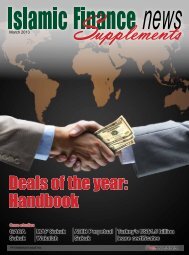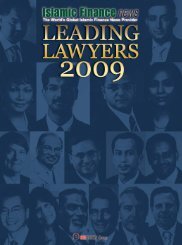View PDF Edition - Islamic Finance News
View PDF Edition - Islamic Finance News
View PDF Edition - Islamic Finance News
Create successful ePaper yourself
Turn your PDF publications into a flip-book with our unique Google optimized e-Paper software.
sector report<br />
Chart 1: Global Sukuk market trend (US$m)<br />
280,000<br />
240,000<br />
200,000<br />
160,000<br />
120,000<br />
80,000<br />
40,000<br />
23,097<br />
23,419<br />
38,346<br />
55,348<br />
20,283<br />
69,387<br />
34,104<br />
95,720<br />
53,083<br />
122,981<br />
85,577<br />
177,453<br />
139,269<br />
242,524<br />
700<br />
600<br />
500<br />
400<br />
300<br />
200<br />
100<br />
Chart 2: 2012 Z-spread/Discount Margin trend<br />
(sample of international Sukuk)<br />
Min Max Current<br />
1,550<br />
1,250<br />
950<br />
650<br />
350<br />
2006 2007 2008 2009 2010 2011 2012<br />
New issues (US$ million)<br />
Year End Outstanding amount (US$ million)<br />
# <strong>News</strong> Issues (RHS)<br />
Source: Zawya.com and Alkhair Capital calculation<br />
50<br />
CBB14<br />
CBB18<br />
ADIBUH16<br />
FGBUH17<br />
TDIC14<br />
EIBUH17<br />
EIBUH18<br />
HSBC16<br />
TAMWEE17<br />
DPWDU17<br />
JAFZA19<br />
EMAAR16<br />
EMAAR19<br />
NAKHL16<br />
MAFUAE17<br />
DUGB17<br />
DUGB22<br />
RAKS16<br />
SIB16<br />
QATAR18<br />
QATAR23<br />
QIB15<br />
QIB17<br />
QIIB17<br />
DARAK15<br />
ISBD17<br />
BFSR17<br />
SECO17<br />
INDOIS14<br />
INDOIS18<br />
PETMK14<br />
MALAYS16<br />
MALAYS21<br />
TURKEY18<br />
KFINKW16<br />
GE14<br />
Source: Bloomberg and Alkhair Capital calculation<br />
Despite Malaysia still representing 56% of the total Sukuk issued<br />
during the year, Saudi Arabia witnessed the most significant<br />
activity with issuances amounting to US$10.4 billion vs US$2.5<br />
billion in 2011. Domestic Sukuk represented 76% of the total<br />
Sukuk issuances vs 82% in 2011. UAE issuers continued to<br />
prefer international Sukuk to local currency issuances. Few<br />
GCC issuers accessed the Malaysian domestic market to issue<br />
ringgit-denominated Sukuk (Taqa US$212.9 million, Mumtalakat<br />
US$98.3 million, National Bank of Abu Dhabi US$163.8 million).<br />
Sukuk issued in the MENA countries during 2012 amounted to<br />
36% of the total bond and Sukuk issued by MENA issuers. The<br />
preference for Sukuk over conventional bonds increased during<br />
the year and the number of GCC Sukuk reached 34 issuances<br />
from 19 in 2011 (10 issuances in 2010).<br />
Despite the European credit<br />
crisis and social unrest in<br />
the MENA region, Sukuk have<br />
been perceived as a safe haven<br />
asset class, reporting another year<br />
of positive performance<br />
Secondary market: Steady performance continued<br />
Despite the European credit crisis and social unrest in the MENA<br />
region, Sukuk have been perceived as a safe haven asset class,<br />
reporting another year of positive performance.<br />
The HSBC/Nasdaq Dubai Sukuk Index returned 9.7% in 2012<br />
(+7.2% in 2011) vs the 4.77% of the Barclays Global Aggregate<br />
Bond Index and 18% of the Barclays Emerging Markets Bond<br />
Index (conventional bond indices). The average spread tightened<br />
from 273.4 basis points (bps) to 182.14 bps. The 30-days average<br />
volatility remained contained at 1.36%.<br />
The return of the Sukuk index has been mainly driven by the<br />
strong performance of Dubai names that continued their rerating<br />
in 2011, thanks to favorable macroeconomic conditions,<br />
smooth refinancing of the maturing debt and the recovery of the<br />
real estate market. The repayment of the US$1 billion Sukuk<br />
maturing in July 2012 by Dar Al Arkan (Saudi Arabia) witnessed<br />
the re-pricing of the issuer credit risk. The overall performance<br />
has also been supported by the existing imbalance between<br />
supply and demand of Sukuk (estimated in 1:3) moving almost<br />
all traded Sukuk to YTD highs, as shown in Chart 2.<br />
2012 also witnessed the first UAE company to miss a maturing<br />
Sukuk repayment. Dana Gas, the Sharjah-based natural gas<br />
producer, defaulted on its US$920 million convertible Sukuk<br />
maturing at the end of October. The company announced in<br />
November that it had reached a restructuring agreement with its<br />
main Sukukholders comprising a partial cash payment and the<br />
issuance of a new Sukuk.<br />
2013 market outlook: Strong pipeline expected<br />
The outlook for the Sukuk market remains bright. The global<br />
demand for Sukuk is forecast to grow to US$900 billion by<br />
2017 (from the current estimated US$300 billion), according to<br />
projections by Ernst & Young’s Global <strong>Islamic</strong> Banking Center of<br />
Excellence.<br />
An additional US$27 billion have already been announced<br />
or rumored for the coming year. Saudi Arabia is expected<br />
to represent 25% of the overall offering in 2013, followed by<br />
Malaysia and UAE, with important issuances including GACA II,<br />
Aramco, Sabic, Maaden, NCB, Almarai and Savola.<br />
The governments of Egypt, the Philippines and Jordan are<br />
expecting to raise money through Sukuk for the first time. Tilal<br />
Development Company, the Omani real estate developer, is<br />
expected to issue the first Sukuk in the country. Focus remains<br />
on the Dubai refinancing risk but there are no major concerns<br />
before 2014 when US$30 billion will mature.<br />
The theme for 2013 is searching for value after years of strong<br />
performance, balancing between risk and returns (in real terms).<br />
consulting www.<strong>Islamic</strong><strong>Finance</strong>Consulting.com<br />
www.<strong>Islamic</strong><strong>Finance</strong>Events.com<br />
The challenge has only just begun.<br />
www.<strong>Islamic</strong><strong>Finance</strong><strong>News</strong>.com<br />
www.<strong>Islamic</strong><strong>Finance</strong>Training.com<br />
www.MIFforum.com<br />
www.MIFmonthly.com<br />
www.MIFtraining.com<br />
www.REDmoneyBooks.com<br />
Marco Mauri, CAIA is the senior director of asset management at<br />
Alkhair Capital Saudi Arabia. He can be contacted at mmauri@<br />
alkhaircapital.com.sa.<br />
February 2013 5


